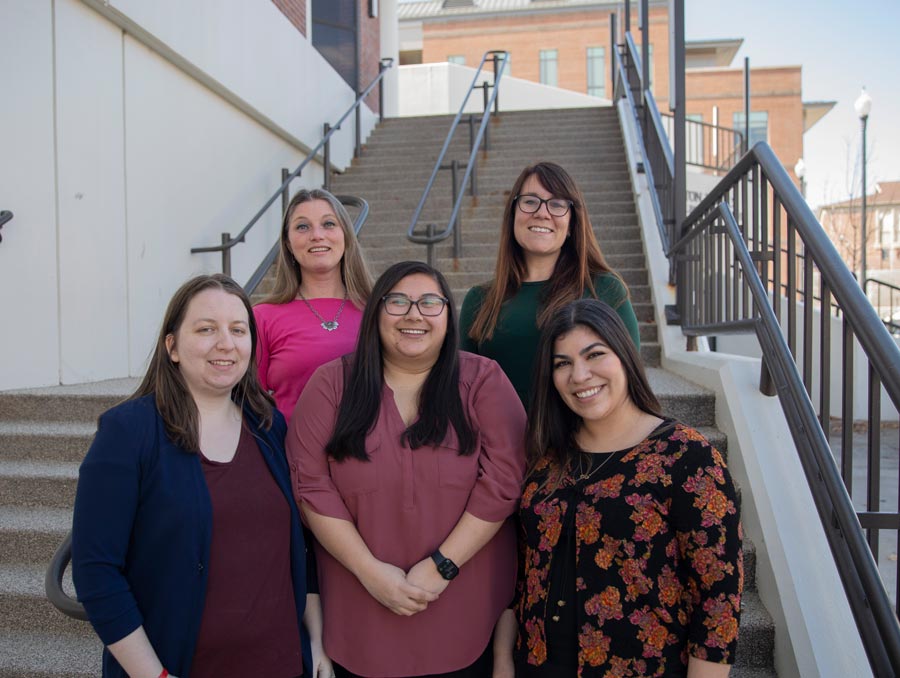Recently published work from the Department of Psychology aims to reconcile two conflicting pieces of evidence about the experiences of people with schizophrenia. An all-female team of researchers discovered some interesting findings.
Marian Berryhill, a professor who studies working memory and attention, collaborated with Sarah Haigh, an assistant professor who studies neurological responses in neurodiverse populations. They, along with graduate students Jenna Pablo, Wendy Alfonso Torrens and Jorja Shires, recently published their findings about how symptoms of schizotypy, or the spectrum of symptoms associated with schizophrenia, are experienced.
The researchers wanted to understand why people who experience schizophrenia report feelings that their senses are being flooded by external stimuli despite the fact that the data, when monitoring the brain, shows neuronal hyporeactivity where the brain responds very little to the same stimuli. To learn what is really going on, they performed a study of schizotypy in the general population.
How can both things be true?
People experiencing schizotypy are non-clinical, meaning they do not experience psychosis, but do experience other schizophrenia-like traits less intensely.
“We are tracking schizotypy in particular, especially people with high schizotypy, because they are sliding up that symptomatology spectrum, but do not yet have a diagnosis [of schizophrenia],” Haigh said. “We don’t have to worry about complications such as duration of disease, medications, any other side effects.”
Complications from medications and disease development would make it difficult to parse out the cause of the symptoms.
“It’s a nicer, easier way to start identifying biomarkers in a sub-clinical, non-clinical population that we can hopefully in the future deploy into a diagnosed population,” Haigh added. “As in most of psychology, there’s a full spectrum.”
To determine how strongly related hyperexcitability is with other non-psychotic symptoms of schizophrenia, the researchers launched an online study. The study had over 900 participants in two trials. The methods involved a self-reporting of symptoms associated with schizotypy called the Schizotypal Personality Questionnaire – Brief Revised. Then, participants would participate in the Pattern Glare Test where they would look at a grated circle and report what they saw in the grating, and be scored based on their responses. There is nothing in the image beyond the grating. The more illusions people reported seeing in the grating, the higher their score on the Pattern Glare Test.
“We want to make progress on understanding where this is coming from,” Berryhill said. “Is it a hypersensitivity or is it a lack of sensitivity? How can both things be true? How can the behavior and the neural findings both be true? What don’t we know?”
When the data were analyzed, the researchers found that the data validated the reported experiences of patients with schizophrenia. Participants who had higher schizotypy traits, determined by the questionnaire, reported more illusions in the Pattern Glare Test. This was counter to what previous neuronal-level research had found.
“When we initially started, we thought, well maybe those with really high symptomatic schizotypy would not show so many illusions on the Pattern Glare, and then the opposite happened,” Haigh said.
The next step for the researchers will be trying to understand what is happening at a neuronal level using an electroencephalogram.
How the results can be used to help others
Because the number of neurotypical, nonclinical participants in the study was high, the researchers were able to see performance across a range of schizotypy in the study.
“We can begin to have clinically relevant findings, even when we’re looking at neurotypical undergrads,” Berryhill said.
“The goal of our research is to find biomarkers of schizophrenia for early identification,” Alfonso Torrens said. “Early identification has shown that with cognitive enhancement therapies and other sorts of therapies, you can improve prognosis. Schizophrenia is a devastating disorder. [People with schizophrenia] have extremely early mortality compared to neurotypical individuals and even compared to other diseases.”
According to the researchers, the benefits of using the Pattern Glare Test in a diagnostic setting is that it’s very easy and fast to deploy and doesn’t cost any money to utilize. They envision that it would be part of a battery of tests but be useful as a screening tool.
Shires, who is epileptic, understands firsthand how important early diagnosis can be. She had been having seizures for seven years before she was diagnosed with epilepsy.
“You can change people’s lives if you can catch it sooner,” Shires said. “That’s really important in the research that I do, I want to be able to help people get better before it gets worse.”
Due to the possibility of the Pattern Glare Test inducing a seizure, the researchers were careful to avoid showing Shires the grated circle.
Collaborative impacts in the Department of Psychology
During their time working on this research, the students also had the opportunity to travel to train with colleagues in other labs, present at conferences, and work with clinical patients.
“We’re very proud that we offer our students broad, varied, enriching training opportunities to the best of our ability,” Berryhill said. “We’re excited to continue to be able to do that, to find other collaborators in other locations who are willing to support our students.”
The collaborations within the Department of Psychology are already strong. For Haigh, working with Berryhill helped her career at the University start strong.
“We got this grant together within a year of me starting,” Haigh said.
The researchers even pushed for more funding to supplement the grant and support students, an indicator of drive that chair of the psychology department Michael Crognale said was rare and impressive.
Pablo, who is supported by the additional diversity grant that Haigh and Berryhill applied for, said that she’s excited for the opportunities Berryhill gives to her graduate students.
“Dr. Berryhill provides a lot of professional development opportunities,” Pablo said.
The impact of women in STEM
For the graduate students, and even for Haigh as an early-career researcher, having female mentors to look up to is important. They said that the field of cognitive neurosciences has a lack of gender diversity, more than in other fields of psychology.
“I’m a cognitive neuroscientist by training,” Berryhill said. “Even when I was in graduate school, there were precious few senior faculty members who were women.”
The field can benefit from a diversity in perspective. Haigh said that there are more males diagnosed with psychiatric conditions than females, and this is true for schizophrenia.
“There is some debate as to whether the symptoms themselves manifest differently or if they are more likely to manifest in a male than a female, or whether it’s just they look slightly different,” Haigh said. “If we shift a little bit, we can be a bit more gender-balanced in that sense so we can give everyone equal help rather than it be kind of looking through one specific lens. I think we can also help with that as well, hopefully.”
As a co-Principle Investigator of the Nevada ENDURE program, Berryhill said that she has noticed the importance of diversity.
“I see it so clearly that the more voices, the more kinds of voices that you have at the table, the better your science and the more you get out of your own pattern of familiarity and your own ways of thinking of things. That is helpful now as I’m getting older, intergenerationally, to hear younger perspectives. It’s helpful for diversity initiatives.”
Alfonso Torrens, on top of being a woman in STEM, is also a Cuban immigrant and has three children.
“It’s doable and it’s all with a passion,” Alfonso Torrens said. “If you love something enough it’s possible.”
All three of the graduate students are interested in pursuing careers in academia, giving them the opportunity to make psychology more diverse and better able to serve its patients in the future.













